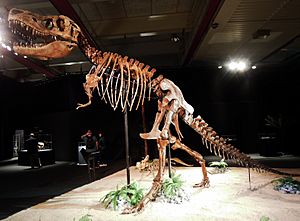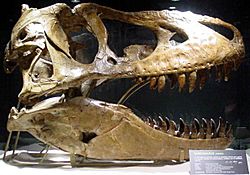Tarbosaurus facts for kids
Quick facts for kids Tarbosaurus |
|
|---|---|
 |
|
| Skeleton on exhibit in Dinosaurium, Prague | |
| Scientific classification | |
| Synonyms | |
|
Genus synonymy
Shanshanosaurus
(Dong, 1977) Maleevosaurus (Carpenter, 1992) Jenghizkhan (Olshevsky, 1995) ?Raptorex (Sereno et al., 2009) Species synonymy
Tyrannosaurus bataar
Maleev, 1955 Gorgosaurus novojilovi Maleev, 1955 Tarbosaurus efremovi Maleev, 1955 Gorgosaurus lancinator Maleev, 1955 Deinodon novojilovi (Maleev, 1955) Deinodon lancinator (Maleev, 1955) Aublysodon lancinator (Maleev, 1955) Charig, 1967 Aublysodon novojilovi (Maleev, 1955) Charig, 1967 Shanshanosaurus huoyanshanensis Dong, 1977 Tyrannosaurus efremovi (Maleev, 1955) Tarbosaurus novojilovi (Maleev, 1955) Aublysodon huoyanshanensis (Dong, 1977) Albertosaurus novojilovi (Maleev, 1955) Maleevosaurus novojilovi (Maleev, 1955) Jenghizkhan bataar (Maleev, 1955) Tyrannosaurus novojilovi (Maleev, 1955) ?Raptorex kriegsteini (Sereno et al., 2009) |
Tarbosaurus was a large carnivorous theropod dinosaur from Asia, especially Mongolia and China. It was a tyrannosaurid dinosaur which flourished between 70 and 65 million years ago, at the end of the Cretaceous period.
Tarbosaurus lived in a humid floodplain criss-crossed by river channels. In this environment, it was a predator at the top of the food chain, probably preying on other large dinosaurs like the hadrosaur Saurolophus or the sauropod Nemegtosaurus.
Tarbosaurus is known from dozens of specimens, with several complete skulls and skeletons. These remains have allowed scientific studies on its phylogeny, skull mechanics, and brain structure.
Comparison with T. rex
Skull
Like its close North American relative Tyrannosaurus rex, it had a large head and powerful jaws, but was not top heavy. Its huge skull was comparatively light, with large air pockets. Many of its bones were hollow, making them strong but light, so they did not add excessive weight to this large predator.
Its skull was similar to that of Tyrannosaurus, but more rigid. Also, because its skull was not so broad at the back, it did not have binocular vision like Tyrannosaurus.
In the lower jaw, a ridge on the outer surface of the angular bone articulated with the rear of the dentary bone, creating a locking mechanism unique to Tarbosaurus and Alioramus. Other tyrannosaurids lacked this ridge and had more flexibility in the lower jaw.
Limbs
Its forlimbs were small with two fingers, as with its larger relative. The small, two-fingered, front limb is absolutely distinctive of tyrannosaurids.
The three-toed hind limbs were long and thick, supporting the body in a bipedal posture. The long, heavy tail served as a counterweight to the head and torso and put the center of gravity over the hips.
Palaeobiology
Some scientists think the more rigid skull of Tarbosaurus was an adaptation to hunting the massive sauropods found in Asia, which did not exist in most of North America during the later Cretaceous.
- "Both Asiatic and North American... tyrannosaurines [NAT] hunted large prey, whilst also being opportunistic scavengers. However, the prey available to them were obviously different... the adult T. rex... probably specialized in bringing down large horned dinosaurs, like Triceratops... but this group was absent outside North America. Thus, the Mongolian tyrannosaurines were forced to feed on sauropods... These differences in typical prey items might have exerted different selective pressures, concerning hunting strategy and mechanical requirements maximizing their success rate as predators".
- "The new material studied in this paper allows us to speculate if the tyrannosaurines can be divided into NATs and an Asiatic group".
Images for kids
-
Holotype skull PIN 551-1, Museum of Paleontology, Moscow
-
Tarbosaurus fossils that were smuggled to the US, and subsequently returned to Mongolia, at New York
-
Cretaceous-aged dinosaur fossil localities of Mongolia; Tarbosaurus was collected in area A (left)










